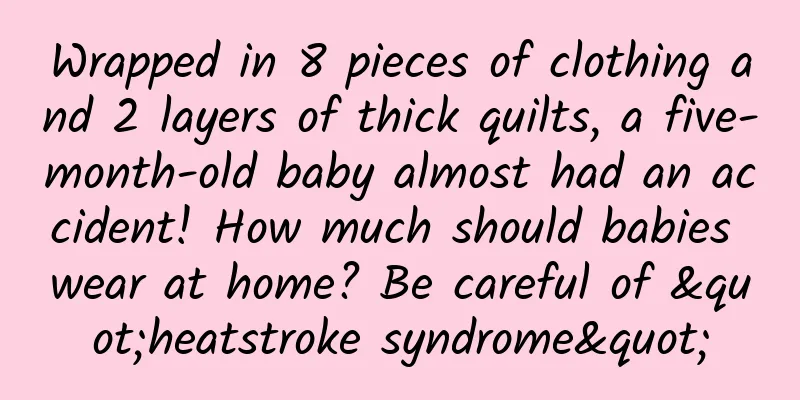Wrapped in 8 pieces of clothing and 2 layers of thick quilts, a five-month-old baby almost had an accident! How much should babies wear at home? Be careful of "heatstroke syndrome"

|
Seriously After becoming a mother I am afraid that my child will be too cold or too hot. The weather is getting colder now The children are wearing cotton coats and trousers. But always pay attention to the child so that he doesn't get too hot. Image source: Pixabay But recently there was news 5 month old baby Wrapped in 8 pieces of clothes + 2 thick quilts When visiting a hospital Hyperthermia and severe dehydration Diagnosed as "Heat syndrome" What disease is this? How serious is it? How to correctly judge Is the baby cold? Let’s learn together below~ What is heat stroke syndrome? Infants under one year old, especially those under one month old, are most susceptible to heat stroke syndrome during the neonatal stage. This often happens in winter and when the temperature drops sharply. In addition, overdressing children, wrapping them in too many blankets, covering them with too thick quilts, high indoor temperatures, and adding heating facilities for fear that children will catch a cold can all lead to overheating syndrome. Children's fast basal metabolism, high heat production and poor heat dissipation function will lead to weaker body temperature regulation function, and their body temperature will be higher when the external temperature is too high. The main symptoms of heat stroke syndrome: 1. The body temperature rises, with high fever or hyperthermia, and the body temperature can reach above 40°C; 2. There are signs of dehydration, sweating profusely, and even clothes are soaked; 3. Pale complexion, weak crying, and refusal to breastfeed; 4. If the quilt is covered too high, it will cause hypoxia, which will lead to slow reaction, impaired consciousness, drowsiness, coma, and even convulsions. If heat stroke syndrome is not detected in time, respiratory failure, arrhythmia, and heart failure will occur. Prolonged hypoxia of the brain will cause brain cell necrosis, leading to permanent sequelae of the central nervous system and even sudden infant death. Image source: Pixabay 7 ways to avoid heat stroke 1. The baby's ability to regulate body temperature is relatively poor. The room temperature for newborns should be controlled at 23~24℃. Babies from a few months to 1 year old should stay in a room with a room temperature of 22℃ and a humidity of about 50%~60%. If the indoor temperature is too dry after heating in the north in winter, you can use a humidifier appropriately. 2. Children's temperature needs are basically the same as adults', so just add clothes to your baby according to the adult standard. Secondly, let's remember to touch the back of the neck . As long as the back of the child's neck is warm and dry, there is no need to add clothes no matter who says so. 3. Do not pile too many things on the baby’s crib . Extra quilts, pillows, and stuffed toys may cover the baby’s head, causing overheating and danger. 4. Do not let your baby sleep with adults . This not only increases the risk of heat stroke syndrome, but also increases the risk of accidentally pressing on the baby's mouth and nose, causing suffocation. 5. Do not use electric blankets or hot water bottles on your baby , as continuous heating may be dangerous. 6. When a child has a fever, he or she should be dressed and covered less, the room should be kept ventilated , and ibuprofen and acetaminophen should be used when necessary, instead of blindly believing in covering up to reduce fever. 7. If your child shows symptoms related to heat stroke syndrome: irritability, red face, sweating, excessive sweating, and little urination , you should immediately loosen the swaddling clothes and take the child to the hospital without hesitation. How to dress warmly without catching a cold? There is a kind of cold called "your mother feels cold." Even if you know what material to choose for your baby's quilt, you will still keep covering your babies with it. In fact, most parents cover their babies incorrectly. Covering too much can even cause heat stroke syndrome, which causes the baby's body temperature to be too high, causing a lot of sweating, and even dehydration in severe cases. In winter, when dressing your baby, you should follow a matching principle: thin pajamas + sleeping bag + light quilt. This way, you don't have to worry about babies catching a cold by kicking off the quilt, and mom and dad can actually have a good sleep. There are so many brands and types of sleeping bags, how do you choose? The editor has also stepped on many pits. This time I summarized the experience and shared it with you: 1. Look at the warmth coefficient The warmth coefficient of a sleeping bag is generally expressed in Tog. The higher the value, the stronger the warmth. There are four Tog levels of common sleeping bags, and mothers can choose according to the actual temperature of their home. 2. Look at the material The inner layer of the sleeping bag directly contacts the baby's skin, so it is recommended to choose a soft, skin-friendly, sweat-absorbent, and breathable cotton material. In addition, babies are more likely to accept it in terms of softness, warmth retention, and skin-friendliness. Suitable for most babies. 3. Look at the style There are many types of sleeping bags, and mothers who have difficulty choosing one really don’t know where to start. But in fact, the choice of sleeping bag style is different for children of different ages. Swaddle Recommended age: 0-3m Swaddle-type sleeping bags are specially designed for babies 0-3m tall. Babies under three months old generally have a startle reflex. Wrapping the baby in this way can avoid disturbed sleep caused by the startle reflex. Envelope Recommended age: 3-6m Envelope-style sleeping bags are the most common, usually sleeveless in design, with an open bottom, suitable for babies who are more afraid of heat. It is recommended that mothers choose detachable styles, which will be more efficient. It is also more suitable for older babies. Split Legs Recommended age: 6m and above After half a year old, split-leg sleeping bags are the longest-lasting and most practical. The split-leg design will not restrict the baby even if he turns over or rolls at night, making his movements more flexible. Be sure to choose a looser style. Contributor: Chongqing Tianji Network Co., Ltd. This article is compiled from: Yuxueyuan, United Family Health Science, Pediatrician Bao Xiulan Statement: Except for original content and special instructions, some pictures are from the Internet, non-commercial use, only as popular science materials, copyright belongs to the original author, if there is any infringement, please contact to delete |
<<: In fact, many people are doing these "knee-injuring" exercises...
>>: What happened to those who wore contact lenses for many years? 4 injuries are hard to avoid →
Recommend
The best time for fetal brain supplementation
The development of the fetus is an issue that man...
Morgan Stanley: 44% of iPad users will reduce office paper usage
According to a statistical study by Morgan Stanle...
What are the precautions for vaginal bleeding?
Women experience vaginal bleeding after intercour...
What causes vaginal discharge?
Many women may have vaginal secretions in their l...
What happened if my period is delayed for a month and I am not pregnant?
Generally speaking, women have their periods once...
Back to school season | As a study partner, does the eye protection lamp really protect your eyes?
...
Pregnant woman with high blood pressure of 150 has given birth to a girl
The physical condition of a pregnant woman will a...
Why do I feel uncomfortable in my stomach during pregnancy?
Pregnancy is an exciting thing. Having your own b...
Will my breasts swell and ache during ovulation?
Breast tenderness may occur during the ovulation ...
People with high blood pressure have to do a lot of tests before taking medicine. Is it for "making money" or is it really necessary?
A friend left a message to Huazi, saying that his...
What tests should be done if the leucorrhea is yellow and has a fishy smell
If the leucorrhea is yellow and has a fishy smell...
How to prepare for pregnancy with Occult cysts? Tips for preparing for pregnancy with a cyst
Although chocolate cyst is a benign disease, it h...
What should I do if the quality of the fertilized egg is poor?
Many friends will find that the quality of their ...
What is the cause of vaginal itching and yellow leucorrhea?
Normal women will have some secretions in their v...









